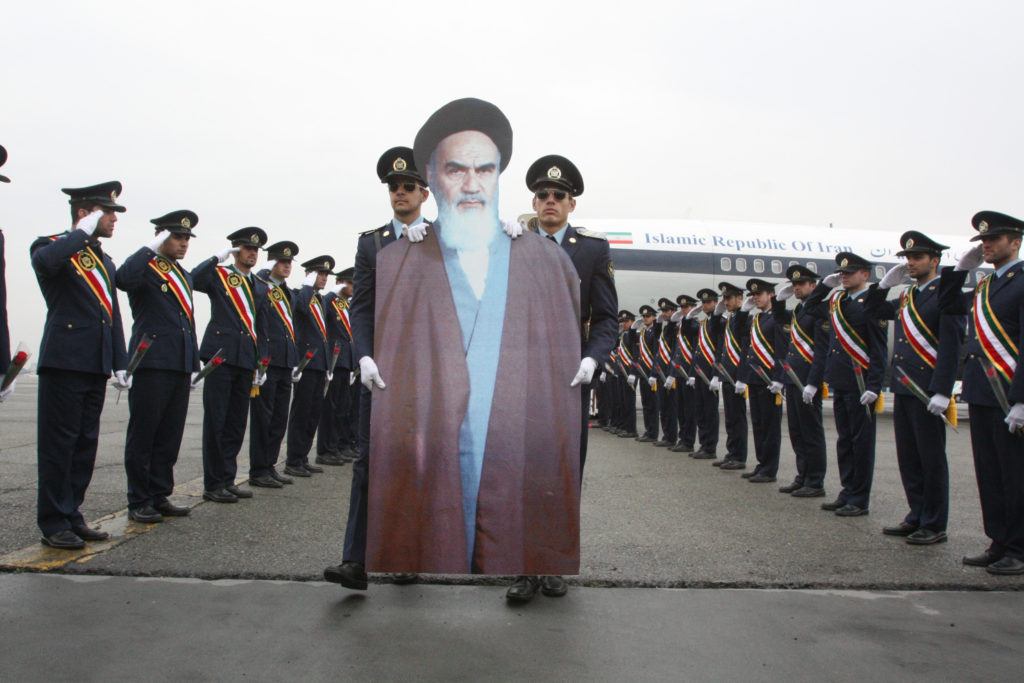Is the Trump administration conniving at a polynuclear Middle East? – Credit: Getty

Even as it conspires with Israel and Saudi Arabia to wreck the Joint Comprehensive Plan of Action nuclear deal struck with Iran in July 2015 (IAEA inspectors have just confirmed for the ninth time that Tehran is fully complying with them), the Trump administration is actively seeking ways to sell nuclear reactors to the Saudis. Its intention is to revive the fortunes of the ailing Westinghouse Electric – a bankrupt US subsidiary of Toshiba which supplies nuclear technology to the US navy while also struggling to complete two power plants in the state of Georgia – before Chinese or Russian buyers swoop in.
To throw such a lifeline to Westinghouse would mean turning a blind-eye to Riyadh’s persistent refusal to rule out enriching uranium and reprocessing plutonium. These two customary pathways to nuclear weapons were ironically being pursued by Iran itself before the July 2015 agreement.
One of the main arguments against Iran’s nuclear weapons programme was that if Tehran got the Bomb, then others in the region would rapidly follow. The JCPOA deal was designed both to restrain Iran for the next 15 years, while precluding the swift onset of a ‘polynuclear’ Middle East, in which Egypt, Saudi Arabia and Turkey would also strive to acquire nuclear weapons.
The most persuasive arguments against the proliferation of nuclear weapons in a manifestly highly unstable region involve contrasts with the relative stability of the ‘high’ Cold War era between the US and Soviet Union and their respective clients. Huge arsenals and a second strike capability guaranteed ‘mutually assured destruction’ (MAD). Elaborate command and control systems mitigated the possibility of the kind of rogue actors depicted in Stanley Kubrick’s 1964 black comedy Dr Strangelove, though we should not forget 32 ‘Broken Arrow’ incidents – in which strategic bombers crashed or nuclear bombs were accidentally released – or that on two occasions in 1983 the northern hemisphere came very close to annihilation.
In the first, Stanislav Petrov, a Soviet colonel, realised that satellite detection of five Minuteman ICMBs launched in the US, which set off alarms in Soviet early-warning computers, had been triggered by sunlight reflected from clouds high over Nebraska. Petrov waited until ground radars determined there was nothing incoming, despite there only being 12 minutes left before a counter launch was required.
In the second ‘incident’, a few months later, Soviet nuclear forces went onto maximum alert after Nato’s ‘Able Archer’ exercise seemed too realistic, as it culminated in escalation to DECON 1 preparatory for the pre-emptive nuclear strike which the Soviet leadership was convinced was coming.[3. For a good overview see L. Douglas Keeney, 15 Minutes. General Curtis LeMay and the Countdown to Nuclear Annihilation (New York 2011)]
A polynuclear Middle East would lack the safeguards of the high Cold War, though it might resemble the more unstable period before MAD and the full-blown nuclear theology was elaborated by technical experts insulated from popular clamour. There are also unavoidable cultural, political and religious distinctions. Most of the region’s regimes are precarious rentier affairs that could be swept away in a heartbeat. After all, in 1978 the US agreed to sell the Shah of Iran two dozen reactors and even access to fuel technology, only to see him overthrown the following year.
Ironically, one of Ayatollah Khomeini’s first acts was to halt the Shah’s nuclear programme, though it was revived to meet the chemical weapons threat from Saddam Hussein. Many informed observers would not care to bet on Saudi Arabia’s impulsive Crown Prince Mohammed bin Salman expiring peacefully in his bed, given the number of powerful enemies he has made in his Icarus-like rise to absolute power. One can only speculate on what might happen in Saudi Arabia should the House of Saud stumble, though most of the scenarios are not good, and they would be even worse with nuclear weapons around.

Several Middle Eastern states have records of military adventurism and brinkmanship, while also subscribing to apocalyptic and suicidal doctrines in which mass casualties would hold few terrors. Whereas any command and control systems would be constantly undermined by religious or tribal authorities, not to mention power-plays between civilians and the military, or angry crowds with cardboard nukes demonstrating on the streets, diplomacy and emergency hotlines would be non-existent in a region shot through with deep sectarian antagonisms.[5. Shmuel Bar ‘A Nuclear Iran and the Ram’]
It is no secret that Saudi Arabia intends to spend up to $80 billion in the next 20-25 years acquiring 16 civil nuclear reactors, so as to conserve the oil and gas used to generate electric power, though the desert Kingdom surely has a lot of sunshine too. China, Russia, France and South Korea are all keen to supply these reactors, via, respectively, China General Nuclear Power Group, Rosatom, Areva and Korea’s KEPCO. Riyadh says it wants to award the first two contracts later this year as part of Crown Prince Mohammed bin Salman’s ambitious Saudi Vision 2030.
The Trump administration is also keen to participate, via a consortium consisting of Westinghouse Electric, Bechtel Group, Exelon and Fluor Corp, but Section 123 of the 1954 US Atomic Energy Act stands in the way of any deal. [6. Ethan Bronner, Jennifer Diohy ‘As Saudis go nuclear, US seeks an edge over great power rivals’ Bloomberg News 20 February 2018 and Reem Shamseddine, Stephen Kalin, Geert De Clerq ‘Westinghouse discussing group bid for Saudi nuclear tender’ Reuters Business News 21 November 2017]
This law gives Congress the power to review any sale of nuclear technology that might involve enriching uranium or reprocessing plutonium to make nuclear weapons. In other words, the very activities that the agreement with Iran was intended to thwart in return for alleviation of sanctions. Hitherto, it has been widely assumed that were Riyadh in need of the Bomb, it would borrow one from Pakistan whose nuclear programme it financed. After all, it does seem able to hire out Pakistani soldiers whenever it likes.
The UAE, though, has beaten the Saudis to it, with four Korean-built reactors at Barakah, two of which start to come on line later this year under a 2008 deal which cost the UAE $24 billion. These will be the first since, in the interim, the UAE has gone down the solar route in a major way. Ironically, the government of Moon Jae-in in Seoul decided last year to bail out of nuclear power after sundry safety scandals, while still exporting the technology.
This UAE deal is dubbed the ‘gold standard’ since it prohibits any in-country enrichment activity. The UAE has no domestic sources of uranium, unlike Iran and Saudi Arabia.

The Saudis are refusing to enter into any discussions with Westinghouse Electric, unless the US administration eases Section 123 restrictions, on the grounds that the JCPOA permits Iran peaceful enrichment for medical isotopes and the like, although Iran’s plutonium pathway has been shut down. The nuclear core at the Arak heavy water reactor was removed and filled with concrete in 2016. Some members of the Saudi royal family have also indicated that they want to have nuclear weapons.
Despite this, Energy Secretary Rick Perry has been in Riyadh discussing a Westinghouse deal, which would help Trump realise his promise to revitalise the US nuclear industry. Westinghouse urgently needs the deal after its two US-based AP1000 ran into problems and were abandoned half completed. It needs to justify and recoup the enormous costs of developing the AP1000 model too.
One of the many murky side-enterprises of General Mike Flynn – briefly Trump’s transitional National Security Advisor – was lobbying the Jordanians and others on behalf of US nuclear power interests in conjunction with other retired generals dabbling in commerce. This pattern of crony capitalism seems to be thriving in the administration.
The Trump cabinet has also discussed such a deal with Saudi Arabia, with Jared Kushner as chief enthusiast, but as yet the National Security Council has not given a verdict on the national security implications. Expect claims that US involvement in the Saudi nuclear plans would give the US control, or that as a nuclear threshold state, Saudi Arabia would ‘deter’ Iran should it seek such weapons in 15 years time, or in the event the nuclear deal falls apart.[10. These claims are comprehensively demolished by Victor Gulinsky and Henry Sokolski ‘No to a permissive US-Saudi nuclear deal’ Bulletin of the Atomic Scientists 22 February 2018]
One compromise solution, proposed by Obama’s non-proliferation expert, Robert Einhorn, has been for the Saudis to agree to a 15 years moratorium on enrichment and reprocessing, which mirrors the JCPOA which the Trump administration is bent on ‘revising’. Revising means sabotaging, or at least pushing the Iranians to renege on the deal themselves, should the Chinese, Russians and three European powers not persuade Trump of its utility. The Iranians are already talking about acquiring nuclear powered ships and submarines in response to Trump’s threats.
A final imponderable is how the Israelis will react, since their stated objective has been to ensure that they remain the sole, albeit ‘opaque’, nuclear weapons state in the region. They may conclude that it is better to have the US involved in any Saudi nuclear plants than for this to be left to the Chinese and Russians, though the latter’s record on counter proliferation is actually good. Perhaps the abrupt transformation in Israeli eyes of Saudi Arabia from malignant actor, responsible for the global propagation of anti-Semitism and jihadism into favoured ally against Iran, will also mean revising multiple warnings about a ‘polynuclear’ Middle East?
Since Egypt, Jordan and Turkey are also at various stages of acquiring civil nuclear reactors, a kind of slow motion polynuclear Middle East is already in motion. Whether the Trump administration should be actively conniving at this disastrous outcome seems doubtful, while the murky interface of foreign policy and obscure business interests is a chronic problem in an administration being run as an extension to a family business. It also means that the Trump administration has to swallow any indignity from Riyadh. The latest being Saudi Arabia blocking US efforts to include Pakistan on the international Financial Action Task Force’s watch list of state sponsors of terrorism.










Join the discussion
Join like minded readers that support our journalism by becoming a paid subscriber
To join the discussion in the comments, become a paid subscriber.
Join like minded readers that support our journalism, read unlimited articles and enjoy other subscriber-only benefits.
Subscribe